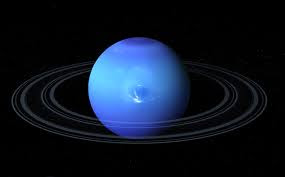Neptune
"Neptune: The Mysterious Blue Planet"
Neptune is the eighth and farthest known planet from the Sun in our solar system. It is the fourth-largest planet by diameter and the third-largest by mass. Neptune is named after the Roman god of the sea due to its striking blue color, reminiscent of the ocean.
Here are some key facts about Neptune:
Distance from the Sun: Neptune is located about 4.5 billion kilometers (2.8 billion miles) away from the Sun on average. Its orbit is highly elliptical, and it takes approximately 165 Earth years to complete one orbit around the Sun.
Size and Composition: Neptune has a diameter of about 49,500 kilometers (30,800 miles), making it nearly four times larger than Earth. It has a dense atmosphere composed mostly of hydrogen and helium, along with traces of methane, which gives the planet its blue color.
Moons: Neptune has 14 known moons, the largest of which is Triton. Triton is unique among the moons in our solar system because it has a retrograde orbit, meaning it orbits Neptune in the opposite direction of the planet's rotation. Other notable moons include Nereid, Proteus, and Larissa.

Rings: Like other gas giant planets, Neptune has a system of rings. These rings are composed of ice particles and are much fainter and less prominent than the rings of Saturn. The rings are named after astronomers who made significant discoveries related to Neptune, such as Galle, Le Verrier, and Lassell.
Exploration: The only spacecraft to visit Neptune is NASA's Voyager 2, which flew by the planet in 1989. Voyager 2 provided valuable data and images of Neptune and its moons, revealing details about the planet's atmosphere and geology.
Characteristics: Neptune has a dynamic atmosphere with high-speed winds and large storm systems. The most famous storm on Neptune is the Great Dark Spot, which was observed by the Hubble Space Telescope in 1989 but has since disappeared. Another notable feature is the "scooter," a dark spot observed in the atmosphere that moves at high speeds.
It's worth noting that my knowledge cutoff is in September 2021, so there may have been new discoveries or information about Neptune since then.
Neptune is the eighth and farthest known planet from the Sun in our solar system. It is the fourth-largest planet by diameter and the third-largest by mass. Neptune is named after the Roman god of the sea due to its striking blue color, reminiscent of the ocean.
Here are some key facts about Neptune:
Distance from the Sun: Neptune is located about 4.5 billion kilometers (2.8 billion miles) away from the Sun on average. Its orbit is highly elliptical, and it takes approximately 165 Earth years to complete one orbit around the Sun.
Size and Composition: Neptune has a diameter of about 49,500 kilometers (30,800 miles), making it nearly four times larger than Earth. It has a dense atmosphere composed mostly of hydrogen and helium, along with traces of methane, which gives the planet its blue color.
Moons: Neptune has 14 known moons, the largest of which is Triton. Triton is unique among the moons in our solar system because it has a retrograde orbit, meaning it orbits Neptune in the opposite direction of the planet's rotation. Other notable moons include Nereid, Proteus, and Larissa.

Rings: Like other gas giant planets, Neptune has a system of rings. These rings are composed of ice particles and are much fainter and less prominent than the rings of Saturn. The rings are named after astronomers who made significant discoveries related to Neptune, such as Galle, Le Verrier, and Lassell.
Exploration: The only spacecraft to visit Neptune is NASA's Voyager 2, which flew by the planet in 1989. Voyager 2 provided valuable data and images of Neptune and its moons, revealing details about the planet's atmosphere and geology.
Characteristics: Neptune has a dynamic atmosphere with high-speed winds and large storm systems. The most famous storm on Neptune is the Great Dark Spot, which was observed by the Hubble Space Telescope in 1989 but has since disappeared. Another notable feature is the "scooter," a dark spot observed in the atmosphere that moves at high speeds.
It's worth noting that my knowledge cutoff is in September 2021, so there may have been new discoveries or information about Neptune since then.
#Neptune
#BluePlanet
#OuterPlanet
#SolarSystem
#SpaceExploration
#GiantPlanet
#NeptunianMoons
#Astronomy
#PlanetaryScience
#Voyager2
#NeptuneFacts
#NeptuneDiscovery
#SpaceMission
#NeptuneAtmosphere
#NeptuneRings
#BluePlanet
#OuterPlanet
#SolarSystem
#SpaceExploration
#GiantPlanet
#NeptunianMoons
#Astronomy
#PlanetaryScience
#Voyager2
#NeptuneFacts
#NeptuneDiscovery
#SpaceMission
#NeptuneAtmosphere
#NeptuneRings
Facebook: https://www.facebook.com/profile.phpid=100087106114908
Twitter : https://twitter.com/bestpaperaward
Pinterest : https://in.pinterest.com/bestpaperaward
Linkedin : https://www.linkedin.com/in/esha-gupta-18b2b4245
Instagram: https://www.instagram.com/eshagupta__2022/
Twitter : https://twitter.com/bestpaperaward
Pinterest : https://in.pinterest.com/bestpaperaward
Linkedin : https://www.linkedin.com/in/esha-gupta-18b2b4245
Instagram: https://www.instagram.com/eshagupta__2022/



Comments
Post a Comment